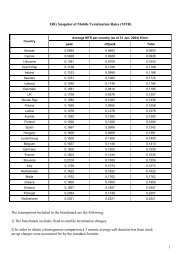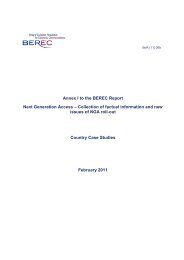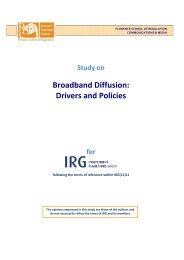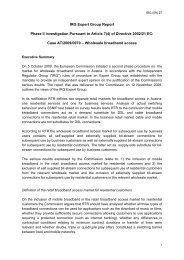You also want an ePaper? Increase the reach of your titles
YUMPU automatically turns print PDFs into web optimized ePapers that Google loves.
<strong>IRG</strong>-WG RA (<str<strong>on</strong>g>07</str<strong>on</strong>g>) <strong>WACC</strong> Master Doc<br />
already used by many regulators. In calculating <strong>WACC</strong> NRAs should c<strong>on</strong>sider the<br />
relative merits of pre-tax vs. post–tax.<br />
3.2 The gearing ratio<br />
The weighting used in the <strong>WACC</strong> formula is the company's gearing. The gearing is a<br />
measure of the ratio of debt to company value (the latter being equivalent to the sum of debt<br />
(D) and equity (E)) and is defined as:<br />
D<br />
Gearing =<br />
D + E<br />
There are a number of ways to determine the gearing level, each with a direct effect <strong>on</strong> the<br />
cost of capital:<br />
a) Based <strong>on</strong> book values: the gearing is calculated using the accounting value of the<br />
company's debt and equity. This is a transparent method, easy to check and audit. The<br />
downside with the use of book value is that it is not forward-looking and does not reflect<br />
the company's true ec<strong>on</strong>omic value. Besides, book values are dependent <strong>on</strong> the<br />
operator's strategic and accounting policy and so they may vary substantially with<br />
changes in the accounting principles, provided general accounting rules are respected;<br />
b) Based <strong>on</strong> market values: the gearing can be calculated <strong>on</strong> the basis of the observed<br />
market value of the company's debt and equity, namely its market capitalisati<strong>on</strong>, which in<br />
theory will reflect the true ec<strong>on</strong>omic value of the company's capital structure. The market<br />
value of equity can be obtained by multiplying the number of shares with their current<br />
price. The market value of debt can be difficult to obtain directly since besides b<strong>on</strong>ds<br />
firms generally have other forms of n<strong>on</strong>-traded debt, such as bank debt. However, book<br />
values can be c<strong>on</strong>verted into market values by treating the entire book debt as <strong>on</strong>e<br />
coup<strong>on</strong> b<strong>on</strong>d. 2 This coup<strong>on</strong> b<strong>on</strong>d would be valued at the current cost of debt for the<br />
company. However, the problem with the use of market values is that they are dependent<br />
<strong>on</strong> several market factors, namely volatility, investors' expectati<strong>on</strong>s and speculati<strong>on</strong> and<br />
so they can be subject to serious fluctuati<strong>on</strong>s, negatively affecting market stability.<br />
c) Optimal or efficient gearing: is based <strong>on</strong> an optimal capital structure defined by the<br />
regulator. The reas<strong>on</strong> for using this method is to ensure that firms that over-borrow or<br />
borrow at too high a rate are not rewarded for this financial decisi<strong>on</strong>. This efficiency<br />
adjustment can be d<strong>on</strong>e by taking into account the capital structure of an efficient<br />
operator rather than the structure of actual operators. 3 However, establishing an optimal<br />
ratio is a subjective issue.<br />
2<br />
The coup<strong>on</strong> should be set equal to the interest expenses <strong>on</strong> all the debt and the maturity set equal to<br />
the weighted average maturity of all debt.<br />
3<br />
The definiti<strong>on</strong> of an optimal capital structure has to take into account several factors such as market<br />
risk, tax advantages, credit ratings, investment levels, and so <strong>on</strong>.<br />
8







